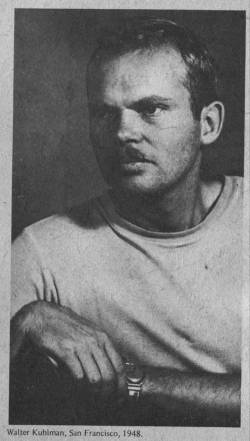Walter Kuhlman: Sausalito Abstract Expressionist
 Tuesday, November 16, 2010 at 11:46PM
Tuesday, November 16, 2010 at 11:46PM Walter Kuhlman: Sausalito Abstract Expressionist
by Peter Arnott
"I was there during the heyday -- when it was really jumping. There were lots of poets, writers and painters. Abstract expressionism was gung-ho. We didn't care if we were famous.” (From a Walter Kuhlman interview.)
When you’re a pioneer, sometimes you may not be aware of it. All you know is it’s an exciting time, and you’re surrounded by exciting people -- creating what will be later acknowledged by art historians as the first specifically American art movement to achieve worldwide influence.
We’re in the 1940s and ‘50s, and there’s something new happening in New York and San Francisco that has turned the eyes of the Art World away from Paris. Abstract Expressionism. In this case, American Abstract Expressionism.
Just as, following WWI, avant-garde writers like Ernest Hemmingway and Ezra Pound flocked to Gertrude Stein’s salon in Paris to take part in a renaissance of American literature, so, following WWII, avant-garde artists flocked to San Francisco to take part in a renaissance of American art.
One of those avant-garde artists is Walter Kuhlman, the son of Danish immigrants, who left his native Minnesota to enlist in the Navy, where he served as an illustrator in the Medical Corps, prompting a later art critic to observe that Kuhlman’s contact with the dead and wounded may be responsible for “the fearful shadow side of human nature” found in his paintings.
Now, out of the Navy, he moves to San Francisco, where he takes advantage of the G. I. Bill to join other veterans at the California School of Fine Art in what is considered “the golden era” of that institution. Many students have already been to art school, and some, like Kuhlman, have already worked as professionals before the war. For Kuhlman, the school is not so much about “instructors and students” as it is about “older artists and younger artists.” And the thrill of -- together -- creating something new.
Kuhlman remembers... “It was not like the organized art schools today where everybody is degree-nutty. In those days, the school was so free. You’d come in in the mornings, paint until two o’clock, then go down to Bruno’s and drink wine.” Kuhlman continues, “I never even got a certificate from the school. I guess they gave them, but it didn’t matter. We were painting. We didn’t care if we were famous. We were all out of the war -- and survived. We didn’t look to tomorrow. We just painted.”
It was during those years that Kuhlman built a house in Sausalito. It’s still there, on Glen Court, still in the family. He built it himself at a cost of $5,000. In 1950, Kuhlman left the school to spend a year in Paris, after which he returned to Sausalito -- there to spend the next 58 years.
In 1955, Kuhlman was the first artist to rent a space in the Industrial Center Building -- beginning a tradition that continues today. You’re welcome to drop in to ICB Room 335, and visit the Kuhlman Gallery.
Over the years, Kuhlman has been honored with many distinguished awards. “But,” he says, in his quiet, self-effacing way, “you can’t find happiness in the minds of others.”
Today, examples of Kuhlman’s ground-breaking work hang in major museums around the world, including the Museum of Modern Art in San Francisco, the Metropolitan Museum of Art in New York, and the British Museum in London.
And he has graced the faculties of several Bay Area institutions, such as Stanford University, Santa Clara University -- and Sonoma State University, where he taught for two decades.
After a long and distinguished career, Walter Kuhlman died in March of 2009 at the age of 90. During his lifetime, when asked to comment on his art, Kuhlman typically looks inward. “I just get the canvas dirty,” he says, “and then dream into it.” And he continues, “It’s the emergence of life ... living things coming out of a shadow ... I never know what happens.”
And finally, the confession of the truly talented: “How do I know?” Walter Kuhlman says, “I just do it.”
Two Walter Kuhlman monotypes are included in the exhibit “Artistic Sausalito,” along with original works by other artists from the 1940s and ’50s who gave Sausalito its reputation as an art colony. The public is invited to view the exhibit on Wednesdays and Saturdays from 10 AM to 2 PM at the Historical Society Gallery, Sausalito City Hall, Second Floor.

Walter Kuhlman lived and worked in Sausalito for most of his long life.
Photo courtesy of Sausalito Historical Society

Reader Comments